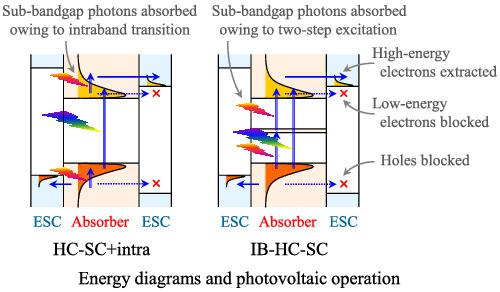当前位置:
X-MOL 学术
›
Prog. Photovoltaics
›
论文详情
Our official English website, www.x-mol.net, welcomes your
feedback! (Note: you will need to create a separate account there.)
Hot-carrier solar cells and improved types using wide-bandgap energy-selective contacts
Progress in Photovoltaics ( IF 8.0 ) Pub Date : 2021-08-30 , DOI: 10.1002/pip.3460 Yasuhiko Takeda 1
Progress in Photovoltaics ( IF 8.0 ) Pub Date : 2021-08-30 , DOI: 10.1002/pip.3460 Yasuhiko Takeda 1
Affiliation

|
I evaluated conversion efficiency of hot-carrier solar cells (HC-SCs) of the original type and two improved types: an HC-SC with intraband transition (HC-SC+intra) and an intermediate-band-assisted HC-SC (IB-HC-SC) that utilize sub-bandgap photons. For this purpose, three realistic points of great importance were involved in the newly constructed detailed-balance model: Shockley–Read–Hall (SRH) recombination of photogenerated carriers, characteristics of the energy-selective contacts (ESCs), and solar spectrum variation. I have revealed that the HC-SC+intra and IB-HC-SC can potentially yield annual electricity production comparable to those of triple-junction and quad-junction solar cells (3J- and 4J-SCs) when sub-bandgap photons are almost perfectly absorbed. The ESCs consisting of wide-bandgap layers extract the photogenerated carriers more rapidly owing to their larger conductance and consequently yield higher conversion efficiency than the ESCs using resonant tunneling diodes composed of quantum dots and quantum wells. This, in turn, enables the use of an absorber with a short SRH recombination time of the carriers. In other words, the efficiency is less sensitive to SRH recombination than those of the 3J- and 4J-SCs. In particular, for the IB-HC-SC, the requisite of the SRH recombination time is 1 ns, and that of the thermalization time is 0.1 ns; the latter is an order of magnitude shorter than the previous requisite. These HC-SCs are more robust against the solar spectrum variation because they are free from the current-matching problem unlike the 3J- and 4J-SCs, which also contributes to the large annual electricity production.
中文翻译:

热载流子太阳能电池和使用宽带隙能量选择接触的改进型
我评估了原始类型和两种改进类型的热载流子太阳能电池 (HC-SC) 的转换效率:带内跃迁的 HC-SC (HC-SC+intra) 和中间带辅助的 HC-SC (IB -HC-SC),利用子带隙光子。为此,新构建的详细平衡模型涉及三个非常重要的现实点:光生载流子的肖克利-雷德-霍尔 (SRH) 复合、能量选择接触 (ESC) 的特征和太阳光谱变化。我已经透露 HC-SC+intra 和 IB-HC-SC 的年发电量可能与三结和四结太阳能电池(3J-和 4J-SC)相当完全吸收。与使用由量子点和量子阱组成的谐振隧道二极管的 ESC 相比,由宽带隙层组成的 ESC 由于其更大的电导可以更快地提取光生载流子,因此产生更高的转换效率。反过来,这使得能够使用载流子的 SRH 重组时间较短的吸收剂。换句话说,效率对 SRH 重组的敏感性低于 3J-和 4J-SC。特别是对于IB-HC-SC,SRH重组时间要求为1 ns,热化时间要求为0.1 ns;后者比之前的要求短一个数量级。与 3J- 和 4J-SCs 不同,这些 HC-SCs 对太阳光谱变化更加稳健,因为它们没有电流匹配问题,
更新日期:2021-08-30
中文翻译:

热载流子太阳能电池和使用宽带隙能量选择接触的改进型
我评估了原始类型和两种改进类型的热载流子太阳能电池 (HC-SC) 的转换效率:带内跃迁的 HC-SC (HC-SC+intra) 和中间带辅助的 HC-SC (IB -HC-SC),利用子带隙光子。为此,新构建的详细平衡模型涉及三个非常重要的现实点:光生载流子的肖克利-雷德-霍尔 (SRH) 复合、能量选择接触 (ESC) 的特征和太阳光谱变化。我已经透露 HC-SC+intra 和 IB-HC-SC 的年发电量可能与三结和四结太阳能电池(3J-和 4J-SC)相当完全吸收。与使用由量子点和量子阱组成的谐振隧道二极管的 ESC 相比,由宽带隙层组成的 ESC 由于其更大的电导可以更快地提取光生载流子,因此产生更高的转换效率。反过来,这使得能够使用载流子的 SRH 重组时间较短的吸收剂。换句话说,效率对 SRH 重组的敏感性低于 3J-和 4J-SC。特别是对于IB-HC-SC,SRH重组时间要求为1 ns,热化时间要求为0.1 ns;后者比之前的要求短一个数量级。与 3J- 和 4J-SCs 不同,这些 HC-SCs 对太阳光谱变化更加稳健,因为它们没有电流匹配问题,











































 京公网安备 11010802027423号
京公网安备 11010802027423号